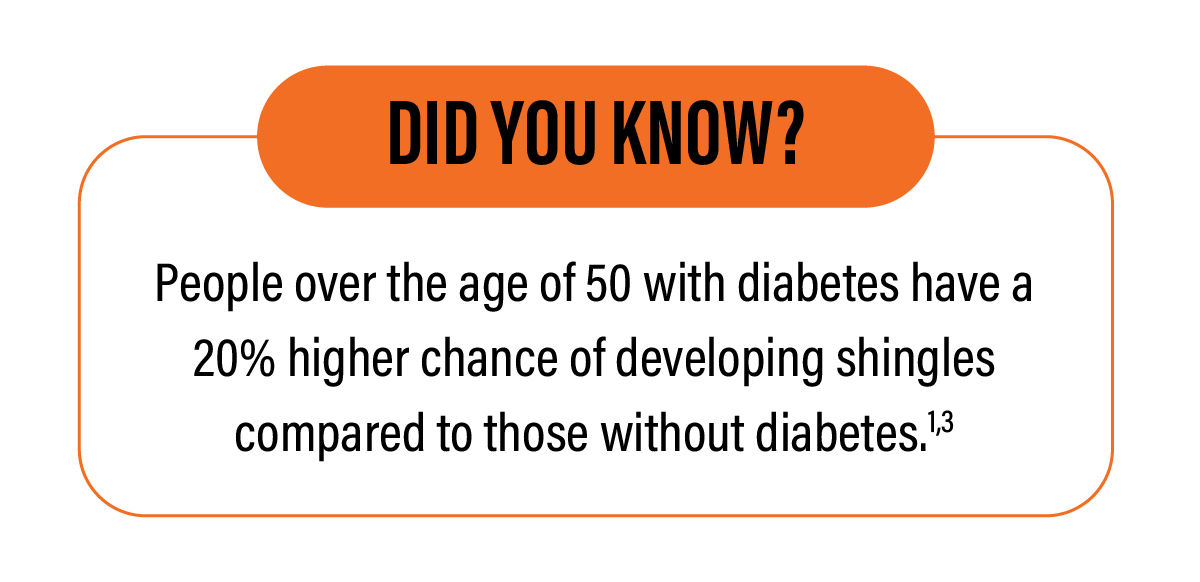Shingles and diabetes are two distinct health conditions, but there seems to be a strong correlation between them, especially in individuals over the age of 50.1,2,3
Diabetes is a chronic disorder that affects the body's ability to regulate blood sugar levels.4 Over time, diabetes can lead to health complications, including vision loss, kidney failure, nerve damage, and an increased risk of cardiovascular disease and stroke.4
Shingles also known as herpes zoster, is a painful viral infection. This is characterised by a localised, blistering rash that typically appears on one side of the body, and occasionally on the neck, and on the face around the eyes.5,6
The infection is caused by the reactivation of the varicella-zoster virus (VZV), the same virus responsible for chickenpox. After recovering from chickenpox, the virus remains dormant in the nerve tissue and may reactivate later in life as shingles.5
Why are people over 50 with diabetes at a higher risk for shingles?
Anyone who has had chickenpox or been exposed to the virus can be affected by shingles. However, individuals with diabetes appear to have a 38% higher risk of developing the condition.1,2,3,7
The exact reason behind this increased risk between shingles and diabetes has yet to be completely understood. However, the primary link appears to lie in the compromised immune system caused by diabetes.1,2
High blood sugar levels and other chronic diseases commonly associated with diabetes, such as cardiovascular and kidney disease, can weaken the immune system. This makes individuals more susceptible to the reactivation of the varicella-zoster virus and the development of shingles.1,2,8
They're also more likely to experience severe symptoms or suffer from other health complications that might require hospitalisation.1,3
The increased risk for people over 50 is associated with several factors as well. These include the natural weakening of the immune system as people age and stressful life events. Debilitating, chronic conditions like asthma, chronic obstructive pulmonary disease, kidney disease, and cardiovascular disease, further compromise the immune systems of older adults.1,8
The combination of a weakened immune system due to diabetes and the natural ageing process can noticeably increase shingles risk among older adults.1, 2

Shingles and diabetes : Potential complications and long-term effects
Worsening diabetic control
Managing blood glucose levels can be challenging during a shingles outbreak, as the inflammatory response triggered by shingles can lead to increased blood glucose levels.1,3 Additionally, stress suffered by the patient may possibly affect appetite and eating habits, potentially impacting diabetic management.9

Secondary Bacterial Infections
Having shingles and diabetes can weaken the immune system further, making individuals more susceptible to secondary infections. These include bacterial infections in the skin or affected areas of the shingles rash, as well as respiratory or urinary tract infections.1,3,10
Long-term nerve pain
People with diabetes are more likely to experience postherpetic neuralgia (PHN), a long-term nerve pain often associated with shingles.11 This can last long after the rash disappears. In some cases, PHN can persist for many years and significantly impact daily life.1,3,12
Slower wound healing
People with diabetes take longer to recover from illnesses, cuts and wounds.13 Infection with bacteria can complicate shingles rash.6

Uses more healthcare resources
Diabetes has also been found to increase the severity of the clinical course of shingles.1 Following this, people with diabetes have been found to make use of more health care resources due to shingles episodes. This includes more outpatient visits, antiviral prescriptions, as well as longer hospitalizations and periods of sick leave.1,3
Prevention is key
People with diabetes, especially older adults, who then contract shingles are more likely to experience complications and long-term effects.1,2 Following this, prevention is crucial when it comes to shingles and diabetes.
Although there is no cure for shingles, there are numerous preventative options and treatments available. Most patients recover fully from an outbreak.14
If you are over 50 and have diabetes it is crucial you consult a healthcare professional to discuss preventive measures.
- Papagianni, M., et al. Diabetes Ther. 2018 Apr; 9(2): 545–550. doi: 10.1007/s13300-018-0394-4.
- Huang CT, et al. The Journal of Clinical Endocrinology & Metabolism, Volume 107, Issue 2, February 2022, Pages 586–597. doi:10.1210/clinem/dgab675.
- Muñoz-Quiles C et al. Hum Vaccin Immunother 2017;13:2606-11.
- World Health Organization. Diabetes. Available at: https://www.who.int/health-topics/diabetes. Accessed October 2023.
- Centers for Disease Control and Prevention. Shingles (Herpes Zoster). Available at: https://www.cdc.gov/shingles/hcp/clinical-overview.html. Accessed October 2023.
- Harpaz R et al. MMWR Recomm Rep 2008;57:1-30; quiz CE2-4.
- Diabetesincontrol.com. Risk of Herpes Zoster in Patients with Diabetes. Available at: https://www.diabetesincontrol.com/risk-of-herpes-zoster-in-patients-with-diabetes/. Accessed October 2023
- Batram M, et al. Dermatol Ther (Heidelb). 2021 Jun;11(3):1009-1026.
- Yau, Y., Potenza, M., Minerva Endocrinol. 2013 Sep; 38(3): 255–267. Accessed October 2023
- Abu-Ashour, W., et al. BMC Infect Dis 18, 67 (2018). doi: 10.1186/s12879-018-2975-2.
- Forbes JH et al. Neurology 2016;87:94-102. doi: 10.1212/WNL.0000000000002808. Accessed October 2023
- Johnson, R. W., et al. International journal of clinical practice, 2009, 63(9), 1386–1391. doi: 10.1111/j.1742-1241.2009.02089.x.
- Centers for Disease Control and Prevention. Diabetes and Your Immune System 2023. Available at: https://www.cdc.gov/diabetes/library/features/diabetes_immune_system.html. Accessed October 2023
- Centers for Disease Control and Prevention. Prevention and Treatment. Available at: https://www.cdc.gov/shingles/about/treatment.html. Accessed October 2023.
- GSK is not responsible for third-party website content.



